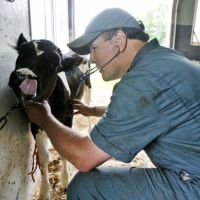This past week, on Wednesday, I sat in on a presentation by Elanco, the worldwide Animal Health Company that provides everything from medicines for your dog to medicines for my family’s cows! This global corporation has always impressed me (plus, on the flier it said free pizza!) Anyways, so I sat in on their presentation and it was fascinating!
I do not know about your majors, but being in the College of Ag, almost every professor at some point talks to us all about the growing population. There are statistics out there saying that by the year 2050, the population will reach 9 billion, and in order to feed these new mouths, we will need to produce 100% more food. Elanco’s study on this issue has declared that 70% of this must come from technology, because there is literally not enough arable land to plant on. This is quite a daunting task to think about.
Not only is this a seemingly impossible task, when you add some of the negative connotations regarding biotechnology among consumers, this is truly a hard feat. What many people don’t realize is that biotechnology can be a lot of things. This can entail finding ways to use less water to produce more wheat. It could involve using genetics to optimize corn production, by growing bigger ears with more corn and thus more food. Biotechnology can be highly scientific, involving chemistry, biology, and engineering, but this does not mean it is not safe. For instance, in 2007 compared to 1944, we can produce 1 gallon of milk with 65% less water and with 90% less land. In 2007 compared to 1977, farmers have been able to produce 1 pound of densely nutritious beef with 14% less water and 34% less land. All of these improvements are due to higher efficiency and biotechnology. (United States Farm Bureau and Elanco) Statistics like this need to continue in order to feed a growing population. However, improving efficiency alone will not do.
It’s time to get excited and creative about the idea of more biotechnology in agriculture, because this is where more of our food will be coming from.
Check out this video, called “Some Food for Thought.” It is really neat!!!!!
I hope this helps you to not only see more of the agriculture around you, but also, start the conversation of food production worldwide, and how to provide enough delicious and nutritious food for a growing population.
-Sarabeth





